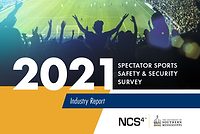Out of sheer necessity, sports security has been evolving rapidly since the Boston Marathon bombing, and most sports security professionals refer to that particular event as a turning point. Metal detectors have become commonplace in major league stadiums, new security policies have been formed, and even tailgating was banned at this year’s Super Bowl. From the monitoring of social media to simulation software and beyond, sports security professionals are using a wide variety of technology to mitigate risks to fans, players and personnel at sporting events.
Social Media
Monitoring chatter on Facebook and Twitter can yield information on potential security threats as fans post ideas and plans, says The Associated Press. “It’s definitely advantageous to venue ownership to think about implementing a social media strategy for your security staff,” says James DeMeo, a Sports Security Professional who specializes in Brand Protection and Risk Mitigation for Event Management. “Security can monitor social media prior to, during, and after an event to kind of get a flow of what may transpire.”
Simulation Software
The National Center for Spectator Sports Safety and Security (NCS4) has partnered with an organization called INCONTROL to develop a simulation software called SportEvac, which helps with training and planning, says Daniel Ward, Coordinator of Training, Exercise and Assessment at NCS4. “It gives us the ability to work with different venues to get an accurate map out of their specific sites, and we can simulate things that are more difficult to exercise and execute on their end,” he says. “It’s kind of difficult to get people to come in and sit in the stadium, so what the simulation software does is based on the parameters the organization gives us and their specific plans. We’re able to design and lay out their stadium and populate it with simulated agents, and we can get an idea of how long it would take for people to actually come into the stadium, and how long it would take to evacuate.”
Phone Apps
Many sports venues now have phone apps where customers can upgrade their seats, find maps of the facility, and order food from their seats. They can also “tap into the app at that arena and anonymously request security assistance,” says DeMeo. Texting is another means. “(Fans) can just anonymously text, and that information goes through a security app platform and it’s monitored, and then that information can be relayed to dispatch security staff to that area to try to resolve a problem before it actually happens,” he says.
Security Cameras
“The capability of the cameras themselves and the systems that are associated with them are the biggest improvements (to technology),” says Jonathan Lusher, proprietor at I3 Security Services. “We can use more cameras at lower cost than we were ever able to use. We can use cameras that have analytics. The ability to discern certain behaviors can be programmed into cameras and…we’re able to record things much more usably. Computerized searching has made it possible to find things almost instantaneously in hours and hours of recording,” he says.
“It’s also important that the people that are sitting on the controls are properly trained on how to utilize the camera technology to kind of zone in and out, and be able to potentially avert problems by seeing things in advance. It gives the security manager the ability to dispatch staff to certain areas to potentially break up fights,” says DeMeo.
Web-Based Assessments
NCS4 does external assessments for the collegiate community, but for K-12, “We’ve just recently set up a Web-based assessment, and it allows us to work with high schools so that they can submit their plans and programs and information specific to their sites and venues on a secure work space. We can go in and provide an external assessment to them from a remote location, so we don’t have to actually physically go there. It allows us to keep costs down and work with that specific target audience,” says Ward.
Online Resource Libraries
“One of the big things that we’ve done in the world of technology is we’ve set up a national resource library on our website, and it allows us to populate documents that can be shared with sports safety and security professionals around the nation. We’re able to compile best practices and different documents and tools for them to utilize,” Ward says. Check out www.ncs4.com.
Digital Two-Way Radios
Not only are digital two-way radios cost-effective, they have better sounding audio, a higher level of security, and the ability to look up necessary information instantly, according to RCR Wireless News.
The ability to contact certain groups of people, such as staff who might be near an altercation in a sports arena, is also beneficial, Lusher says. “The dispatcher, for instance, can have a GPS locator in every radio that is being used, so if I need to get a security officer to an event that’s occurring, a fight or whatever, I know who the closest person is because it shows up on my screen where the person is located,” he says.
Emergency Preparedness Programs
“What it allows you to do is, first of all, you can video record the entire premise. Some of the radios that I described have video screens built into them. If I want to show a video to the guard who’s responding to a problem, I can do that, but the emergency preparedness system has already recorded every square inch of the facility and that video would be available both online and on a CD type of media so that if there’s an incident, a need to evacuate or whatever it may be, we can actually see what was recorded,” says Lusher. “But more importantly what it allows us to do is to actually look at all the video cameras on the property in real time and have the fire department or the police department, or whatever, looking at those cameras when they respond to the scene. And therefore they’re able to see what’s going on and what to do about it that second that they get there. We’re highly prepared to be ahead of these kinds of incidents.”
License Plate Recognition Software
“A lot of the casinos were the first to use license plate recognition to recognize the cars of people that they didn’t want (there). They could cut them off before they actually got indoors. We also use this at places like racetracks where quite a number of people are banned for various integrity reasons,” says Lusher.
While technology has clearly made security professionals’ jobs easier in many ways, “the most important thing that I have learned over the (past 40) years is that you cannot only use technology. You have to have a three-part integrated approach,” Lusher says. “One of them is technology, one of them is the design and the build of a particular facility, and the other one is the use of people, such as security officers or police.”





